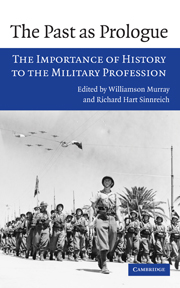Book contents
- Frontmatter
- Contents
- Contributors
- 1 Introduction
- 2 Military history and the history of war
- Part I The influence of history on the military profession
- Part II The past as illuminator of the future
- 7 Thucydides as educator
- 8 Clausewitz, history, and the future strategic world
- 9 History and the nature of strategy
- 10 Military transformation in long periods of peace: the Victorian Royal Navy
- 11 Military history and the pathology of lessons learned: the Russo-Japanese War, a case study
- 12 Obstacles to innovation and readiness: the British Army's experience, 1918–1939
- 13 What history suggests about terrorism and its future
- 14 History and future of civil–military relations: bridging the gaps
- Index
14 - History and future of civil–military relations: bridging the gaps
Published online by Cambridge University Press: 05 June 2012
- Frontmatter
- Contents
- Contributors
- 1 Introduction
- 2 Military history and the history of war
- Part I The influence of history on the military profession
- Part II The past as illuminator of the future
- 7 Thucydides as educator
- 8 Clausewitz, history, and the future strategic world
- 9 History and the nature of strategy
- 10 Military transformation in long periods of peace: the Victorian Royal Navy
- 11 Military history and the pathology of lessons learned: the Russo-Japanese War, a case study
- 12 Obstacles to innovation and readiness: the British Army's experience, 1918–1939
- 13 What history suggests about terrorism and its future
- 14 History and future of civil–military relations: bridging the gaps
- Index
Summary
As the small group of insiders filed out of the president's office, they were sure one of them would never be back. It was November 1938, and President Franklin Delano Roosevelt had just met with his most trusted advisors and military leaders. He had called the meeting in the aftermath of the Munich debacle to find a way of deterring Hitler's apparently insatiable ambitions. Roosevelt proposed to build 10,000 airplanes a year as a strategic deterrent. He suggested no other increases to American defenses – neither ground forces nor the requisite aviation support. As he went around the room, the president's personal advisors seemed to be in complete support. Wrapping up the meeting and pleased with the apparent consensus, Roosevelt turned to the only individual who had not spoken, asking, “Don't you think so, George.” The newly minted Army deputy chief of staff, Major General George C. Marshall, responded, “I am sorry, Mr. President, but I don't agree with that at all.” The president appeared startled, and the other participants were surprised at Marshall's blunt candor. They believed he had committed a serious gaffe and that his career prospects were over. But the one advisor with the temerity to suggest that the president was wrong would not have considered any other answer. He was merely stating his professional judgment as requested.
- Type
- Chapter
- Information
- The Past as PrologueThe Importance of History to the Military Profession, pp. 247 - 266Publisher: Cambridge University PressPrint publication year: 2006



